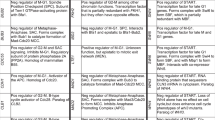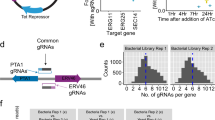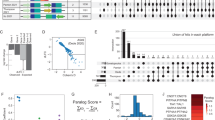Abstract
Systematic complex genetic interaction studies have provided insight into high-order functional redundancies and genetic network wiring of the cell. Here, we describe a method for screening and quantifying trigenic interactions from ordered arrays of yeast strains grown on agar plates as individual colonies. The protocol instructs users on the trigenic synthetic genetic array analysis technique, τ-SGA, for high-throughput screens. The steps describe construction of the double-mutant query strains and the corresponding single-mutant control query strains, which are screened in parallel in two replicates. The screening experimental set-up consists of sequential replica-pinning steps that enable automated mating, meiotic recombination and successive haploid selection steps for the generation of triple mutants, which are scored for colony size as a proxy for fitness, which enables the calculation of trigenic interactions. The procedure described here was used to conduct 422 trigenic interaction screens, which generated ~460,000 yeast triple mutants for trigenic interaction analysis. Users should be familiar with robotic equipment required for high-throughput genetic interaction screens and be proficient at the command line to execute the scoring pipeline. Large-scale screen computational analysis is achieved by using MATLAB pipelines that score raw colony size data to produce τ-SGA interaction scores. Additional recommendations are included for optimizing experimental design and analysis of smaller-scale trigenic interaction screens by using a web-based analysis system, SGAtools. This protocol provides a resource for those who would like to gain a deeper, more practical understanding of trigenic interaction screening and quantification methodology.
This is a preview of subscription content, access via your institution
Access options
Access Nature and 54 other Nature Portfolio journals
Get Nature+, our best-value online-access subscription
$29.99 / 30 days
cancel any time
Subscribe to this journal
Receive 12 print issues and online access
$259.00 per year
only $21.58 per issue
Buy this article
- Purchase on Springer Link
- Instant access to full article PDF
Prices may be subject to local taxes which are calculated during checkout








Similar content being viewed by others
Data availability
A sample dataset for quantifying MTC1-MDY2 trigenic interactions and the corresponding MTC1 and MDY2 digenic interactions is available at https://github.com/ElenaK35/TrigenicSGA_CaseStudy. τ-SGA scores, which are included for comparison, are from a previous study11. Trigenic interaction datasets can be browsed interactively at http://boonelab.ccbr.utoronto.ca/supplement/kuzmin2018/supplement.html and http://boonelab.ccbr.utoronto.ca/paralogs/. They were also deposited in the DRYAD Digital Repository (https://datadryad.org/stash/dataset/doi:10.5061/dryad.tt367) and (https://datadryad.org/stash/dataset/doi:10.5061/dryad.g79cnp5m9), respectively.
Code availability
Scripts for τ-SGA scoring pipeline are available on GitHub at https://github.com/csbio/SGA_Public. The release for τ-SGA interaction scoring is available at https://github.com/csbio/SGA_Public/releases/tag/tau_score_v1.1.0.
References
Bateson, W. R. S. E., Punnett, R. C. & Hurst, C. C. Reports to the Evolution Committee of the Royal Society, Report II (Harrison and Sons, 1905).
Baryshnikova, A. et al. Quantitative analysis of fitness and genetic interactions in yeast on a genome scale. Nat. Methods 7, 1017–1024 (2010).
Novick, P. & Botstein, D. Phenotypic analysis of temperature-sensitive yeast actin mutants. Cell 40, 405–416 (1985).
Bender, A. & Pringle, J. R. Use of a screen for synthetic lethal and multicopy suppressee mutants to identify two new genes involved in morphogenesis in Saccharomyces cerevisiae. Mol. Cell. Biol. 11, 1295–1305 (1991).
Srivas, R. et al. A network of conserved synthetic lethal interactions for exploration of precision cancer therapy. Mol. Cell 63, 514–525 (2016).
Fong, P. C. et al. Inhibition of poly(ADP-ribose) polymerase in tumors from BRCA mutation carriers. N. Engl. J. Med. 361, 123–134 (2009).
Costanzo, M. et al. Global genetic networks and the genotype-to-phenotype relationship. Cell 177, 85–100 (2019).
Costanzo, M. et al. A global genetic interaction network maps a wiring diagram of cellular function. Science 353, aaf1420 (2016).
Tong, A. H. et al. Systematic genetic analysis with ordered arrays of yeast deletion mutants. Science 294, 2364–2368 (2001).
van Leeuwen, J. et al. Exploring genetic suppression interactions on a global scale. Science 354, aag0839 (2016).
Kuzmin, E. et al. Systematic analysis of complex genetic interactions. Science 360, eaao1729 (2018).
Kuzmin, E. et al. Exploring whole-genome duplicate gene retention with complex genetic interaction analysis. Science 368, eaaz5667 (2020).
Bowers, J. E., Chapman, B. A., Rong, J. & Paterson, A. H. Unravelling angiosperm genome evolution by phylogenetic analysis of chromosomal duplication events. Nature 422, 433–438 (2003).
Dehal, P. & Boore, J. L. Two rounds of whole genome duplication in the ancestral vertebrate. PLoS Biol. 3, e314 (2005).
Kuzmin, E., Costanzo, M., Andrews, B. & Boone, C. Synthetic genetic arrays: automation of yeast genetics. Cold Spring Harb. Protoc. 2016, pdb.top086652 (2016).
Kuzmin, E., Costanzo, M., Andrews, B. & Boone, C. Synthetic genetic array analysis. Cold Spring Harb. Protoc. 2016, pdb.prot088807 (2016).
Kuzmin, E. et al. Synthetic genetic array analysis for global mapping of genetic networks in yeast. Methods Mol. Biol. 1205, 143–168 (2014).
Richardson, H. E., Wittenberg, C., Cross, F. & Reed, S. I. An essential G1 function for cyclin-like proteins in yeast. Cell 59, 1127–1133 (1989).
Sugawara, N., Wang, X. & Haber, J. E. In vivo roles of Rad52, Rad54, and Rad55 proteins in Rad51-mediated recombination. Mol. Cell 12, 209–219 (2003).
Haber, J. E. et al. Systematic triple-mutant analysis uncovers functional connectivity between pathways involved in chromosome regulation. Cell Rep. 3, 2168–2178 (2013).
Moura de Sousa, J., Balbontin, R., Durao, P. & Gordo, I. Multidrug-resistant bacteria compensate for the epistasis between resistances. PLoS Biol. 15, e2001741 (2017).
Taylor, M. B. & Ehrenreich, I. M. Genetic interactions involving five or more genes contribute to a complex trait in yeast. PLoS Genet. 10, e1004324 (2014).
Celaj, A. et al. Highly combinatorial genetic interaction analysis reveals a multi-drug transporter influence network. Cell Syst. 10, 25–38.e10 (2020).
Li, Z. et al. Systematic exploration of essential yeast gene function with temperature-sensitive mutants. Nat. Biotechnol. 29, 361–367 (2011).
Yan, Z. et al. Yeast Barcoders: a chemogenomic application of a universal donor-strain collection carrying bar-code identifiers. Nat. Methods 5, 719–725 (2008).
McIsaac, R. S. et al. Synthetic gene expression perturbation systems with rapid, tunable, single-gene specificity in yeast. Nucleic Acids Res. 41, e57 (2013).
Smith, J. D. et al. Quantitative CRISPR interference screens in yeast identify chemical-genetic interactions and new rules for guide RNA design. Genome Biol. 17, 45 (2016).
Chong, Y. T. et al. Yeast proteome dynamics from single cell imaging and automated analysis. Cell 161, 1413–1424 (2015).
Mattiazzi Usaj, M. et al. Systematic genetics and single-cell imaging reveal widespread morphological pleiotropy and cell-to-cell variability. Mol. Syst. Biol. 16, e9243 (2020).
Styles, E. B. et al. Exploring quantitative yeast phenomics with single-cell analysis of DNA damage foci. Cell Syst. 3, 264–277.e10 (2016).
Gottert, H., Mattiazzi Usaj, M., Rosebrock, A. P. & Andrews, B. J. Reporter-based synthetic genetic array analysis: a functional genomics approach for investigating transcript or protein abundance using fluorescent proteins in Saccharomyces cerevisiae. Methods Mol. Biol. 1672, 613–629 (2018).
Tsherniak, A. et al. Defining a cancer dependency map. Cell 170, 564–576.e16 (2017).
Gonatopoulos-Pournatzis, T. et al. Genetic interaction mapping and exon-resolution functional genomics with a hybrid Cas9–Cas12a platform. Nat. Biotechnol. 38, 638–648 (2020).
Mair, B. et al. High-throughput genome-wide phenotypic screening via immunomagnetic cell sorting. Nat. Biomed. Eng. 3, 796–805 (2019).
Datlinger, P. et al. Pooled CRISPR screening with single-cell transcriptome readout. Nat. Methods 14, 297–301 (2017).
McFaline-Figueroa, J. L. et al. A pooled single-cell genetic screen identifies regulatory checkpoints in the continuum of the epithelial-to-mesenchymal transition. Nat. Genet. 51, 1389–1398 (2019).
Replogle, J. M. et al. Combinatorial single-cell CRISPR screens by direct guide RNA capture and targeted sequencing. Nat. Biotechnol. 38, 954–961 (2020).
Braberg, H. et al. Quantitative analysis of triple-mutant genetic interactions. Nat. Protoc. 9, 1867–1881 (2014).
Collins, S. R., Schuldiner, M., Krogan, N. J. & Weissman, J. S. A strategy for extracting and analyzing large-scale quantitative epistatic interaction data. Genome Biol. 7, R63 (2006).
Keil, C. et al. Treeview 3.0 (beta 1)—visualization and analysis of large data matrices. Zenodo. https://zenodo.org/record/1303402#.X8fANxNKj-Y (2018).
Baryshnikova, A. Systematic functional annotation and visualization of biological networks. Cell Syst. 2, 412–421 (2016).
Gietz, R. D., Schiestl, R. H., Willems, A. R. & Woods, R. A. Studies on the transformation of intact yeast cells by the LiAc/SS-DNA/PEG procedure. Yeast 11, 355–360 (1995).
Giaever, G. et al. Functional profiling of the Saccharomyces cerevisiae genome. Nature 418, 387–391 (2002).
Sung, M. K., Ha, C. W. & Huh, W. K. A vector system for efficient and economical switching of C-terminal epitope tags in Saccharomyces cerevisiae. Yeast 25, 301–311 (2008).
Wagih, O. et al. SGAtools: one-stop analysis and visualization of array-based genetic interaction screens. Nucleic Acids Res. 41, W591–W596 (2013).
Usaj, M. et al. TheCellMap.org: a web-accessible database for visualizing and mining the global yeast genetic interaction network. G3 (Bethesda) 7, 1539–1549 (2017).
Amberg, D. C., Burke, D. J. & Strathern, J. N. Tetrad dissection. Cold Spring Harb. Protoc. 2006, pdb.prot4181 (2006).
Shannon, P. et al. Cytoscape: a software environment for integrated models of biomolecular interaction networks. Genome Res. 13, 2498–2504 (2003).
Baryshnikova, A. Exploratory analysis of biological networks through visualization, clustering, and functional annotation in Cytoscape. Cold Spring Harb. Protoc. 2016, pdb.prot077644 (2016).
Baryshnikova, A. Spatial analysis of functional enrichment (SAFE) in large biological networks. Methods Mol. Biol. 1819, 249–268 (2018).
Acknowledgements
This work was primarily supported by the National Institutes of Health (R01HG005853; to C.B., B.J.A. and C.L.M.), Canadian Institutes of Health Research (FDN-143264 and FDN-143265; to C.B. and B.J.A.), National Institutes of Health (R01HG005084 and R01GM104975); to C.L.M.) and the National Science Foundation (DBI\0953881; to C.L.M.). Computing resources and data storage services were partially provided by the Minnesota Supercomputing Institute and the University of Minnesota Office of Information Technology, respectively. Additional support was provided by Natural Science and Engineering Research Council of Canada Postgraduate Scholarship-Doctoral PGS D2 (to E.K.), a University of Toronto Open Fellowship (to E.K.) and a University of Minnesota Doctoral Dissertation Fellowship (to B.V.). C.B. is a fellow of the Canadian Institute for Advanced Research (CIFAR).
Author information
Authors and Affiliations
Contributions
E.K., B.V., C.L.M., B.J.A. and C.B. conceived the project. E.K., B.J.A. and C.B. designed the experimental pipeline with assistance from M.C., B.V. and C.L.M. B.V. and C.L.M. designed the high-throughput analysis pipeline with assistance from E.K., M.C., B.J.A., and C.B. M.R. performed user testing of the high-throughput screening analysis software. E.K. designed and implemented the smaller-scale screening analysis pipeline. E.K. and M.R. wrote the manuscript with input and editing from all authors.
Corresponding authors
Ethics declarations
Competing interests
The authors declare no competing interests.
Additional information
Peer review information Nature Protocols thanks Reiko Sugiura and the other, anonymous, reviewer(s) for their contribution to the peer review of this work.
Publisher’s note Springer Nature remains neutral with regard to jurisdictional claims in published maps and institutional affiliations.
Related links
Key references using this protocol
Kuzmin, E. et al. Science 360, eaao1729 (2018): https://doi.org/10.1126/science.aao1729
Kuzmin, E. et al. Science 368, eaaz5667 (2020): https://doi.org/10.1126/science.aaz5667
Rights and permissions
About this article
Cite this article
Kuzmin, E., Rahman, M., VanderSluis, B. et al. τ-SGA: synthetic genetic array analysis for systematically screening and quantifying trigenic interactions in yeast. Nat Protoc 16, 1219–1250 (2021). https://doi.org/10.1038/s41596-020-00456-3
Received:
Accepted:
Published:
Issue Date:
DOI: https://doi.org/10.1038/s41596-020-00456-3
Comments
By submitting a comment you agree to abide by our Terms and Community Guidelines. If you find something abusive or that does not comply with our terms or guidelines please flag it as inappropriate.



